GSBS6001 Managing Under Uncertainty: Decision Making Essay
VerifiedAdded on 2023/05/29
|11
|2255
|103
Essay
AI Summary
This essay examines the complexities of decision-making in a business context, focusing on the interplay between rationality and the realities of human behavior. It explores how leaders navigate uncertainty, manage risks, and make choices that impact organizational sustainability. The essay delves into the influence of human frailties, such as biases and incomplete information, on the decision-making process, contrasting theoretical models with practical scenarios. It reviews literature on risk effects, high stakes, and the impact of decision-making on risk quotients. The analysis considers the role of organizational culture, stakeholder involvement, and the limitations imposed by cognitive elements and biases. The essay also discusses the importance of adaptability, interpretive potential, and the challenges posed by the changing business environment, ultimately arguing that while rational decision-making is a goal, human factors often lead to deviations from the ideal. References from various authors are used to support arguments.
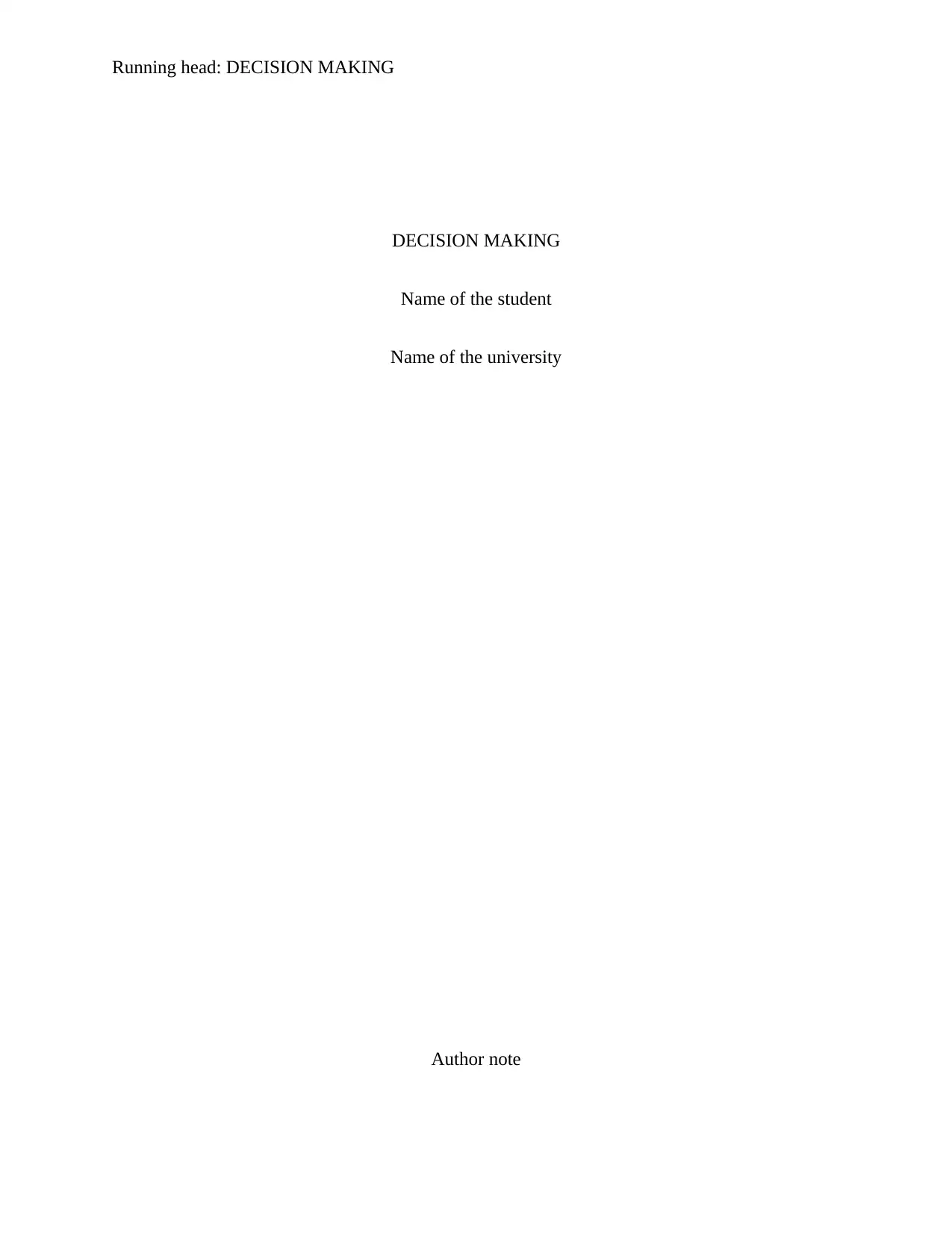
Running head: DECISION MAKING
DECISION MAKING
Name of the student
Name of the university
Author note
DECISION MAKING
Name of the student
Name of the university
Author note
Paraphrase This Document
Need a fresh take? Get an instant paraphrase of this document with our AI Paraphraser
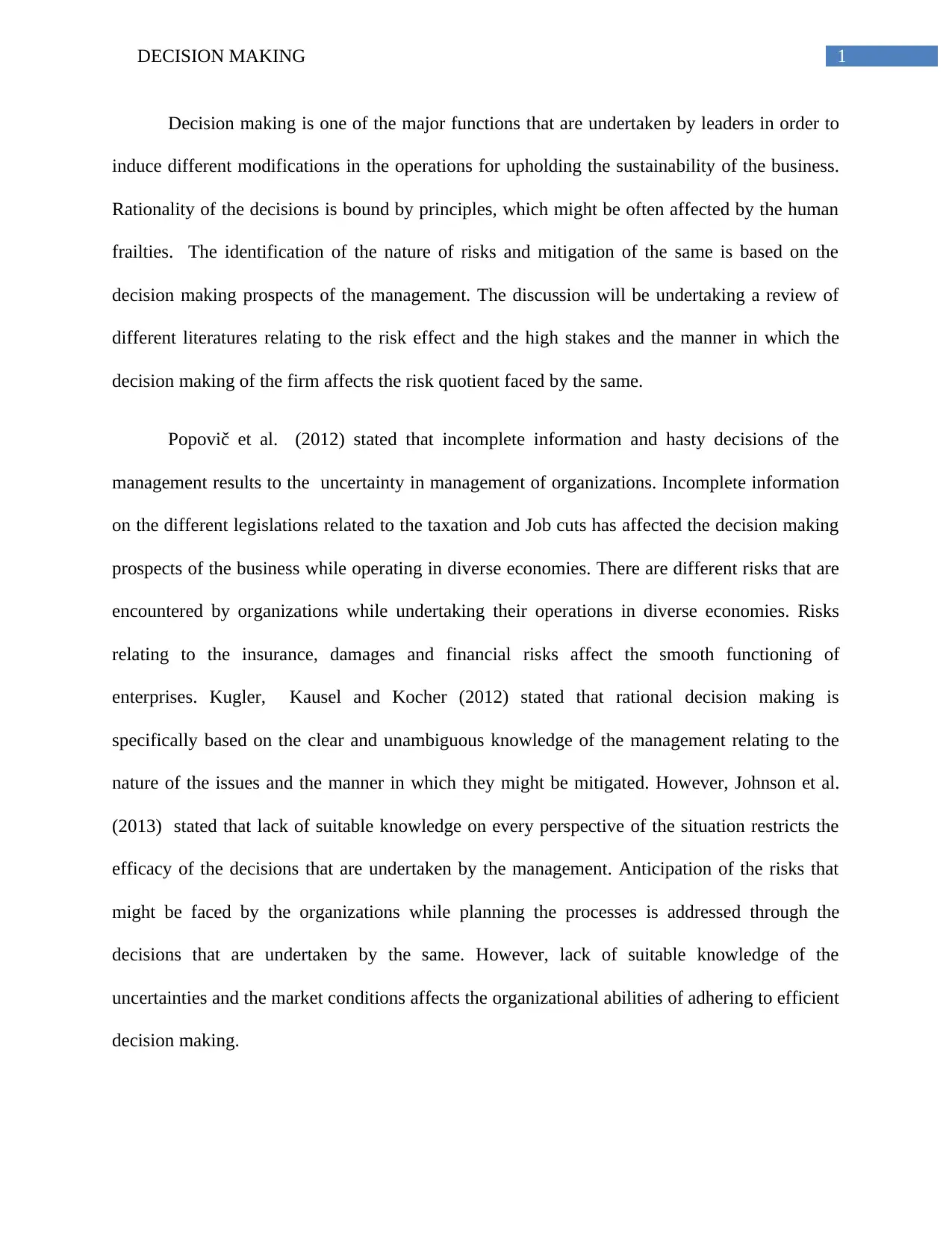
1DECISION MAKING
Decision making is one of the major functions that are undertaken by leaders in order to
induce different modifications in the operations for upholding the sustainability of the business.
Rationality of the decisions is bound by principles, which might be often affected by the human
frailties. The identification of the nature of risks and mitigation of the same is based on the
decision making prospects of the management. The discussion will be undertaking a review of
different literatures relating to the risk effect and the high stakes and the manner in which the
decision making of the firm affects the risk quotient faced by the same.
Popovič et al. (2012) stated that incomplete information and hasty decisions of the
management results to the uncertainty in management of organizations. Incomplete information
on the different legislations related to the taxation and Job cuts has affected the decision making
prospects of the business while operating in diverse economies. There are different risks that are
encountered by organizations while undertaking their operations in diverse economies. Risks
relating to the insurance, damages and financial risks affect the smooth functioning of
enterprises. Kugler, Kausel and Kocher (2012) stated that rational decision making is
specifically based on the clear and unambiguous knowledge of the management relating to the
nature of the issues and the manner in which they might be mitigated. However, Johnson et al.
(2013) stated that lack of suitable knowledge on every perspective of the situation restricts the
efficacy of the decisions that are undertaken by the management. Anticipation of the risks that
might be faced by the organizations while planning the processes is addressed through the
decisions that are undertaken by the same. However, lack of suitable knowledge of the
uncertainties and the market conditions affects the organizational abilities of adhering to efficient
decision making.
Decision making is one of the major functions that are undertaken by leaders in order to
induce different modifications in the operations for upholding the sustainability of the business.
Rationality of the decisions is bound by principles, which might be often affected by the human
frailties. The identification of the nature of risks and mitigation of the same is based on the
decision making prospects of the management. The discussion will be undertaking a review of
different literatures relating to the risk effect and the high stakes and the manner in which the
decision making of the firm affects the risk quotient faced by the same.
Popovič et al. (2012) stated that incomplete information and hasty decisions of the
management results to the uncertainty in management of organizations. Incomplete information
on the different legislations related to the taxation and Job cuts has affected the decision making
prospects of the business while operating in diverse economies. There are different risks that are
encountered by organizations while undertaking their operations in diverse economies. Risks
relating to the insurance, damages and financial risks affect the smooth functioning of
enterprises. Kugler, Kausel and Kocher (2012) stated that rational decision making is
specifically based on the clear and unambiguous knowledge of the management relating to the
nature of the issues and the manner in which they might be mitigated. However, Johnson et al.
(2013) stated that lack of suitable knowledge on every perspective of the situation restricts the
efficacy of the decisions that are undertaken by the management. Anticipation of the risks that
might be faced by the organizations while planning the processes is addressed through the
decisions that are undertaken by the same. However, lack of suitable knowledge of the
uncertainties and the market conditions affects the organizational abilities of adhering to efficient
decision making.
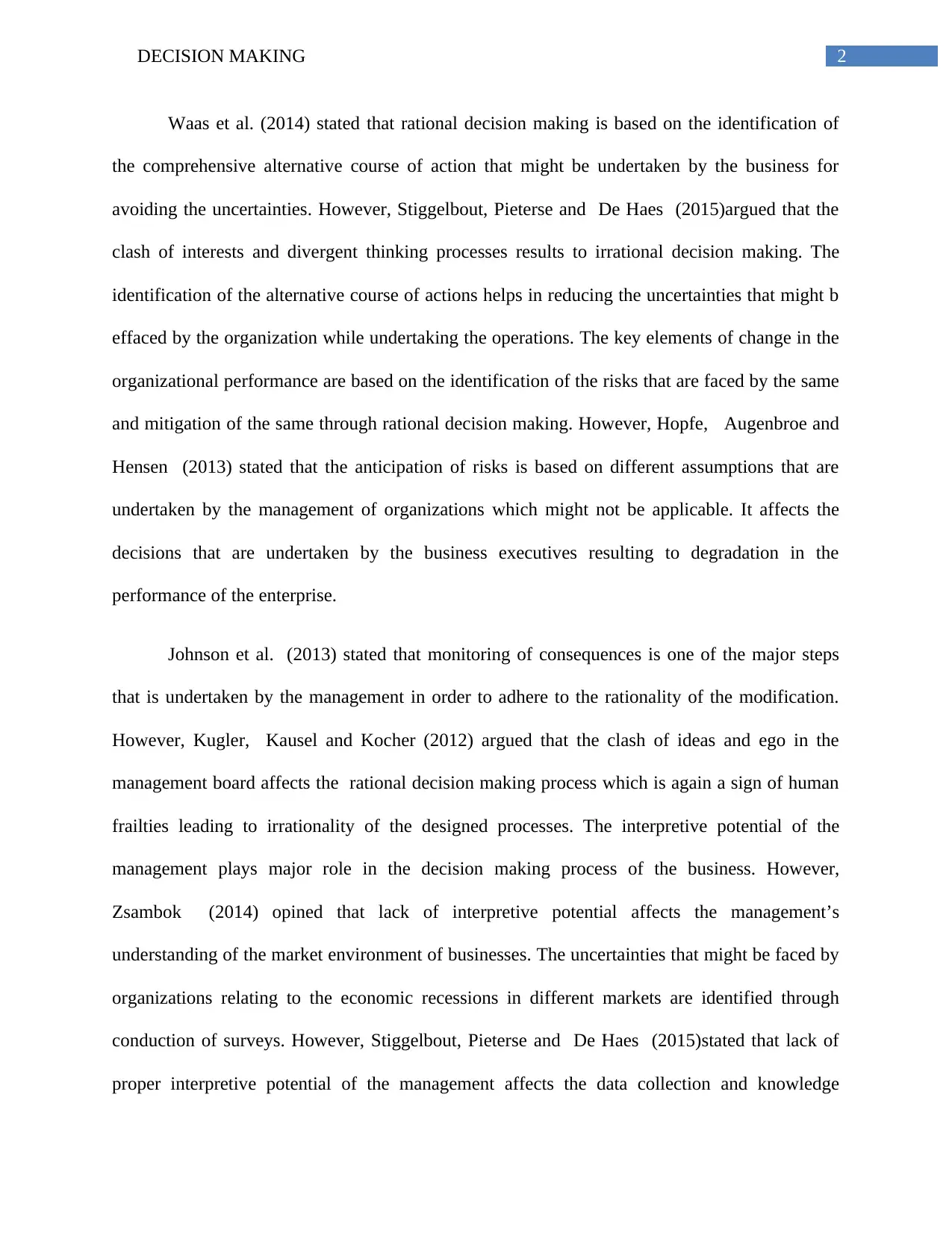
2DECISION MAKING
Waas et al. (2014) stated that rational decision making is based on the identification of
the comprehensive alternative course of action that might be undertaken by the business for
avoiding the uncertainties. However, Stiggelbout, Pieterse and De Haes (2015)argued that the
clash of interests and divergent thinking processes results to irrational decision making. The
identification of the alternative course of actions helps in reducing the uncertainties that might b
effaced by the organization while undertaking the operations. The key elements of change in the
organizational performance are based on the identification of the risks that are faced by the same
and mitigation of the same through rational decision making. However, Hopfe, Augenbroe and
Hensen (2013) stated that the anticipation of risks is based on different assumptions that are
undertaken by the management of organizations which might not be applicable. It affects the
decisions that are undertaken by the business executives resulting to degradation in the
performance of the enterprise.
Johnson et al. (2013) stated that monitoring of consequences is one of the major steps
that is undertaken by the management in order to adhere to the rationality of the modification.
However, Kugler, Kausel and Kocher (2012) argued that the clash of ideas and ego in the
management board affects the rational decision making process which is again a sign of human
frailties leading to irrationality of the designed processes. The interpretive potential of the
management plays major role in the decision making process of the business. However,
Zsambok (2014) opined that lack of interpretive potential affects the management’s
understanding of the market environment of businesses. The uncertainties that might be faced by
organizations relating to the economic recessions in different markets are identified through
conduction of surveys. However, Stiggelbout, Pieterse and De Haes (2015)stated that lack of
proper interpretive potential of the management affects the data collection and knowledge
Waas et al. (2014) stated that rational decision making is based on the identification of
the comprehensive alternative course of action that might be undertaken by the business for
avoiding the uncertainties. However, Stiggelbout, Pieterse and De Haes (2015)argued that the
clash of interests and divergent thinking processes results to irrational decision making. The
identification of the alternative course of actions helps in reducing the uncertainties that might b
effaced by the organization while undertaking the operations. The key elements of change in the
organizational performance are based on the identification of the risks that are faced by the same
and mitigation of the same through rational decision making. However, Hopfe, Augenbroe and
Hensen (2013) stated that the anticipation of risks is based on different assumptions that are
undertaken by the management of organizations which might not be applicable. It affects the
decisions that are undertaken by the business executives resulting to degradation in the
performance of the enterprise.
Johnson et al. (2013) stated that monitoring of consequences is one of the major steps
that is undertaken by the management in order to adhere to the rationality of the modification.
However, Kugler, Kausel and Kocher (2012) argued that the clash of ideas and ego in the
management board affects the rational decision making process which is again a sign of human
frailties leading to irrationality of the designed processes. The interpretive potential of the
management plays major role in the decision making process of the business. However,
Zsambok (2014) opined that lack of interpretive potential affects the management’s
understanding of the market environment of businesses. The uncertainties that might be faced by
organizations relating to the economic recessions in different markets are identified through
conduction of surveys. However, Stiggelbout, Pieterse and De Haes (2015)stated that lack of
proper interpretive potential of the management affects the data collection and knowledge
⊘ This is a preview!⊘
Do you want full access?
Subscribe today to unlock all pages.

Trusted by 1+ million students worldwide
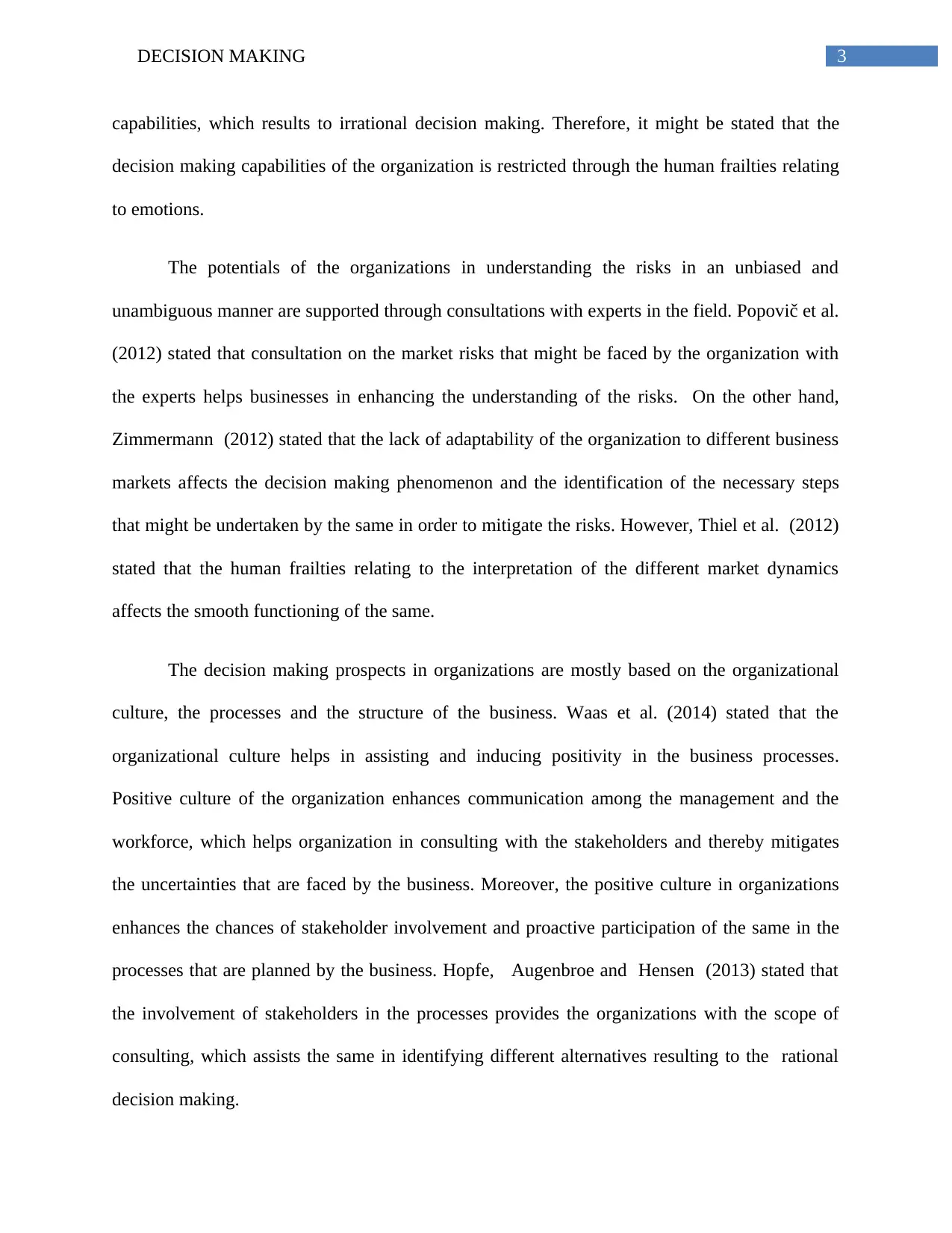
3DECISION MAKING
capabilities, which results to irrational decision making. Therefore, it might be stated that the
decision making capabilities of the organization is restricted through the human frailties relating
to emotions.
The potentials of the organizations in understanding the risks in an unbiased and
unambiguous manner are supported through consultations with experts in the field. Popovič et al.
(2012) stated that consultation on the market risks that might be faced by the organization with
the experts helps businesses in enhancing the understanding of the risks. On the other hand,
Zimmermann (2012) stated that the lack of adaptability of the organization to different business
markets affects the decision making phenomenon and the identification of the necessary steps
that might be undertaken by the same in order to mitigate the risks. However, Thiel et al. (2012)
stated that the human frailties relating to the interpretation of the different market dynamics
affects the smooth functioning of the same.
The decision making prospects in organizations are mostly based on the organizational
culture, the processes and the structure of the business. Waas et al. (2014) stated that the
organizational culture helps in assisting and inducing positivity in the business processes.
Positive culture of the organization enhances communication among the management and the
workforce, which helps organization in consulting with the stakeholders and thereby mitigates
the uncertainties that are faced by the business. Moreover, the positive culture in organizations
enhances the chances of stakeholder involvement and proactive participation of the same in the
processes that are planned by the business. Hopfe, Augenbroe and Hensen (2013) stated that
the involvement of stakeholders in the processes provides the organizations with the scope of
consulting, which assists the same in identifying different alternatives resulting to the rational
decision making.
capabilities, which results to irrational decision making. Therefore, it might be stated that the
decision making capabilities of the organization is restricted through the human frailties relating
to emotions.
The potentials of the organizations in understanding the risks in an unbiased and
unambiguous manner are supported through consultations with experts in the field. Popovič et al.
(2012) stated that consultation on the market risks that might be faced by the organization with
the experts helps businesses in enhancing the understanding of the risks. On the other hand,
Zimmermann (2012) stated that the lack of adaptability of the organization to different business
markets affects the decision making phenomenon and the identification of the necessary steps
that might be undertaken by the same in order to mitigate the risks. However, Thiel et al. (2012)
stated that the human frailties relating to the interpretation of the different market dynamics
affects the smooth functioning of the same.
The decision making prospects in organizations are mostly based on the organizational
culture, the processes and the structure of the business. Waas et al. (2014) stated that the
organizational culture helps in assisting and inducing positivity in the business processes.
Positive culture of the organization enhances communication among the management and the
workforce, which helps organization in consulting with the stakeholders and thereby mitigates
the uncertainties that are faced by the business. Moreover, the positive culture in organizations
enhances the chances of stakeholder involvement and proactive participation of the same in the
processes that are planned by the business. Hopfe, Augenbroe and Hensen (2013) stated that
the involvement of stakeholders in the processes provides the organizations with the scope of
consulting, which assists the same in identifying different alternatives resulting to the rational
decision making.
Paraphrase This Document
Need a fresh take? Get an instant paraphrase of this document with our AI Paraphraser
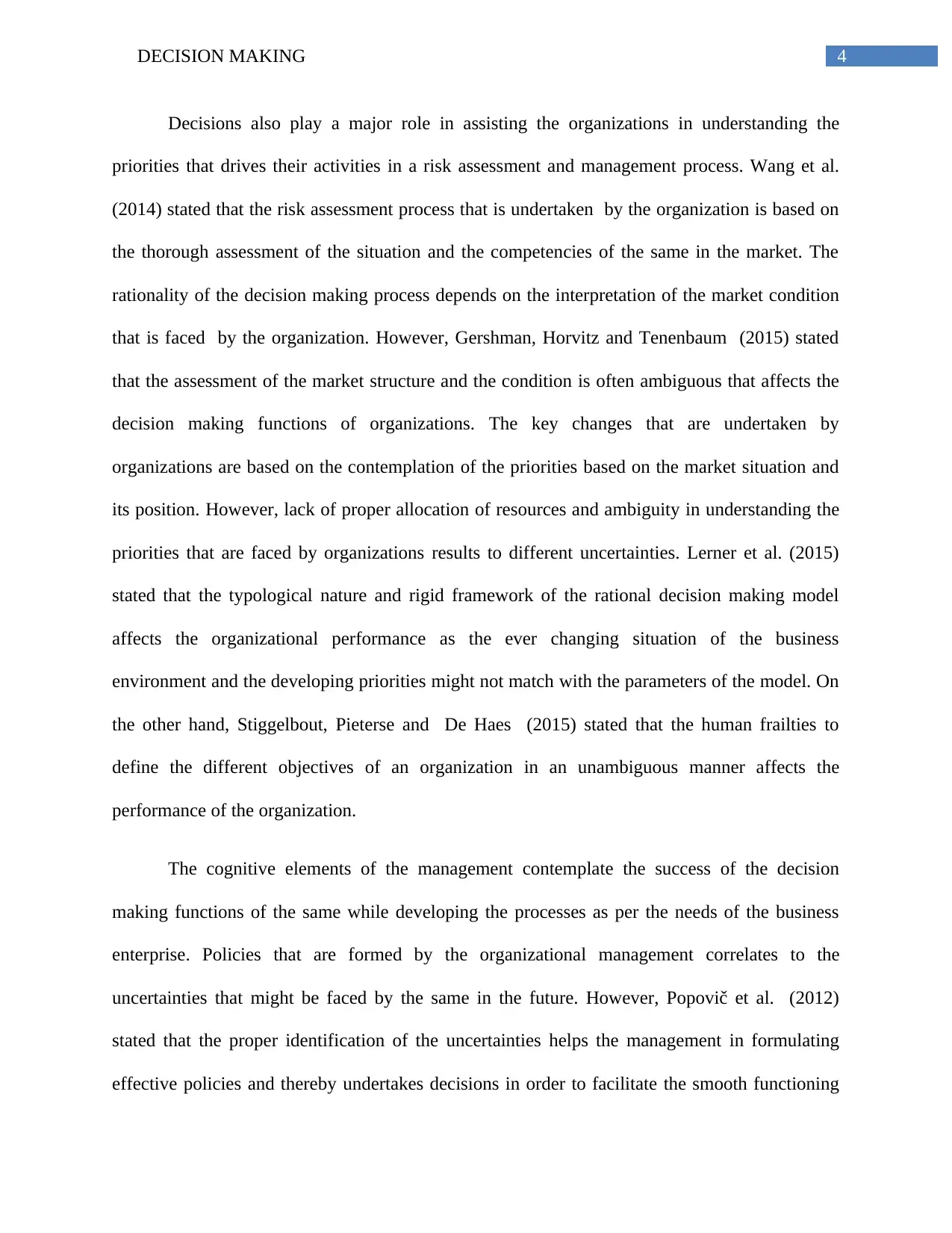
4DECISION MAKING
Decisions also play a major role in assisting the organizations in understanding the
priorities that drives their activities in a risk assessment and management process. Wang et al.
(2014) stated that the risk assessment process that is undertaken by the organization is based on
the thorough assessment of the situation and the competencies of the same in the market. The
rationality of the decision making process depends on the interpretation of the market condition
that is faced by the organization. However, Gershman, Horvitz and Tenenbaum (2015) stated
that the assessment of the market structure and the condition is often ambiguous that affects the
decision making functions of organizations. The key changes that are undertaken by
organizations are based on the contemplation of the priorities based on the market situation and
its position. However, lack of proper allocation of resources and ambiguity in understanding the
priorities that are faced by organizations results to different uncertainties. Lerner et al. (2015)
stated that the typological nature and rigid framework of the rational decision making model
affects the organizational performance as the ever changing situation of the business
environment and the developing priorities might not match with the parameters of the model. On
the other hand, Stiggelbout, Pieterse and De Haes (2015) stated that the human frailties to
define the different objectives of an organization in an unambiguous manner affects the
performance of the organization.
The cognitive elements of the management contemplate the success of the decision
making functions of the same while developing the processes as per the needs of the business
enterprise. Policies that are formed by the organizational management correlates to the
uncertainties that might be faced by the same in the future. However, Popovič et al. (2012)
stated that the proper identification of the uncertainties helps the management in formulating
effective policies and thereby undertakes decisions in order to facilitate the smooth functioning
Decisions also play a major role in assisting the organizations in understanding the
priorities that drives their activities in a risk assessment and management process. Wang et al.
(2014) stated that the risk assessment process that is undertaken by the organization is based on
the thorough assessment of the situation and the competencies of the same in the market. The
rationality of the decision making process depends on the interpretation of the market condition
that is faced by the organization. However, Gershman, Horvitz and Tenenbaum (2015) stated
that the assessment of the market structure and the condition is often ambiguous that affects the
decision making functions of organizations. The key changes that are undertaken by
organizations are based on the contemplation of the priorities based on the market situation and
its position. However, lack of proper allocation of resources and ambiguity in understanding the
priorities that are faced by organizations results to different uncertainties. Lerner et al. (2015)
stated that the typological nature and rigid framework of the rational decision making model
affects the organizational performance as the ever changing situation of the business
environment and the developing priorities might not match with the parameters of the model. On
the other hand, Stiggelbout, Pieterse and De Haes (2015) stated that the human frailties to
define the different objectives of an organization in an unambiguous manner affects the
performance of the organization.
The cognitive elements of the management contemplate the success of the decision
making functions of the same while developing the processes as per the needs of the business
enterprise. Policies that are formed by the organizational management correlates to the
uncertainties that might be faced by the same in the future. However, Popovič et al. (2012)
stated that the proper identification of the uncertainties helps the management in formulating
effective policies and thereby undertakes decisions in order to facilitate the smooth functioning
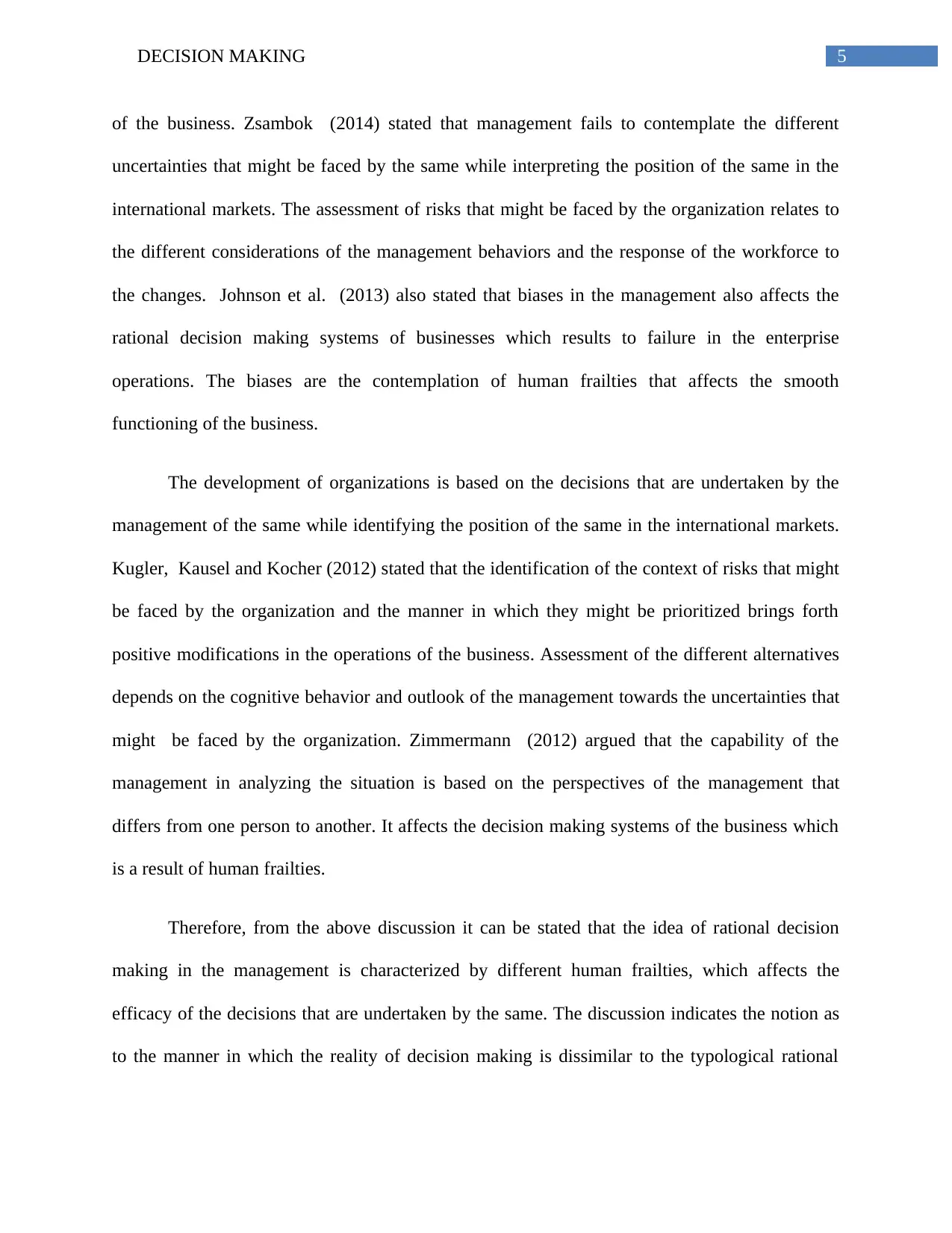
5DECISION MAKING
of the business. Zsambok (2014) stated that management fails to contemplate the different
uncertainties that might be faced by the same while interpreting the position of the same in the
international markets. The assessment of risks that might be faced by the organization relates to
the different considerations of the management behaviors and the response of the workforce to
the changes. Johnson et al. (2013) also stated that biases in the management also affects the
rational decision making systems of businesses which results to failure in the enterprise
operations. The biases are the contemplation of human frailties that affects the smooth
functioning of the business.
The development of organizations is based on the decisions that are undertaken by the
management of the same while identifying the position of the same in the international markets.
Kugler, Kausel and Kocher (2012) stated that the identification of the context of risks that might
be faced by the organization and the manner in which they might be prioritized brings forth
positive modifications in the operations of the business. Assessment of the different alternatives
depends on the cognitive behavior and outlook of the management towards the uncertainties that
might be faced by the organization. Zimmermann (2012) argued that the capability of the
management in analyzing the situation is based on the perspectives of the management that
differs from one person to another. It affects the decision making systems of the business which
is a result of human frailties.
Therefore, from the above discussion it can be stated that the idea of rational decision
making in the management is characterized by different human frailties, which affects the
efficacy of the decisions that are undertaken by the same. The discussion indicates the notion as
to the manner in which the reality of decision making is dissimilar to the typological rational
of the business. Zsambok (2014) stated that management fails to contemplate the different
uncertainties that might be faced by the same while interpreting the position of the same in the
international markets. The assessment of risks that might be faced by the organization relates to
the different considerations of the management behaviors and the response of the workforce to
the changes. Johnson et al. (2013) also stated that biases in the management also affects the
rational decision making systems of businesses which results to failure in the enterprise
operations. The biases are the contemplation of human frailties that affects the smooth
functioning of the business.
The development of organizations is based on the decisions that are undertaken by the
management of the same while identifying the position of the same in the international markets.
Kugler, Kausel and Kocher (2012) stated that the identification of the context of risks that might
be faced by the organization and the manner in which they might be prioritized brings forth
positive modifications in the operations of the business. Assessment of the different alternatives
depends on the cognitive behavior and outlook of the management towards the uncertainties that
might be faced by the organization. Zimmermann (2012) argued that the capability of the
management in analyzing the situation is based on the perspectives of the management that
differs from one person to another. It affects the decision making systems of the business which
is a result of human frailties.
Therefore, from the above discussion it can be stated that the idea of rational decision
making in the management is characterized by different human frailties, which affects the
efficacy of the decisions that are undertaken by the same. The discussion indicates the notion as
to the manner in which the reality of decision making is dissimilar to the typological rational
⊘ This is a preview!⊘
Do you want full access?
Subscribe today to unlock all pages.

Trusted by 1+ million students worldwide
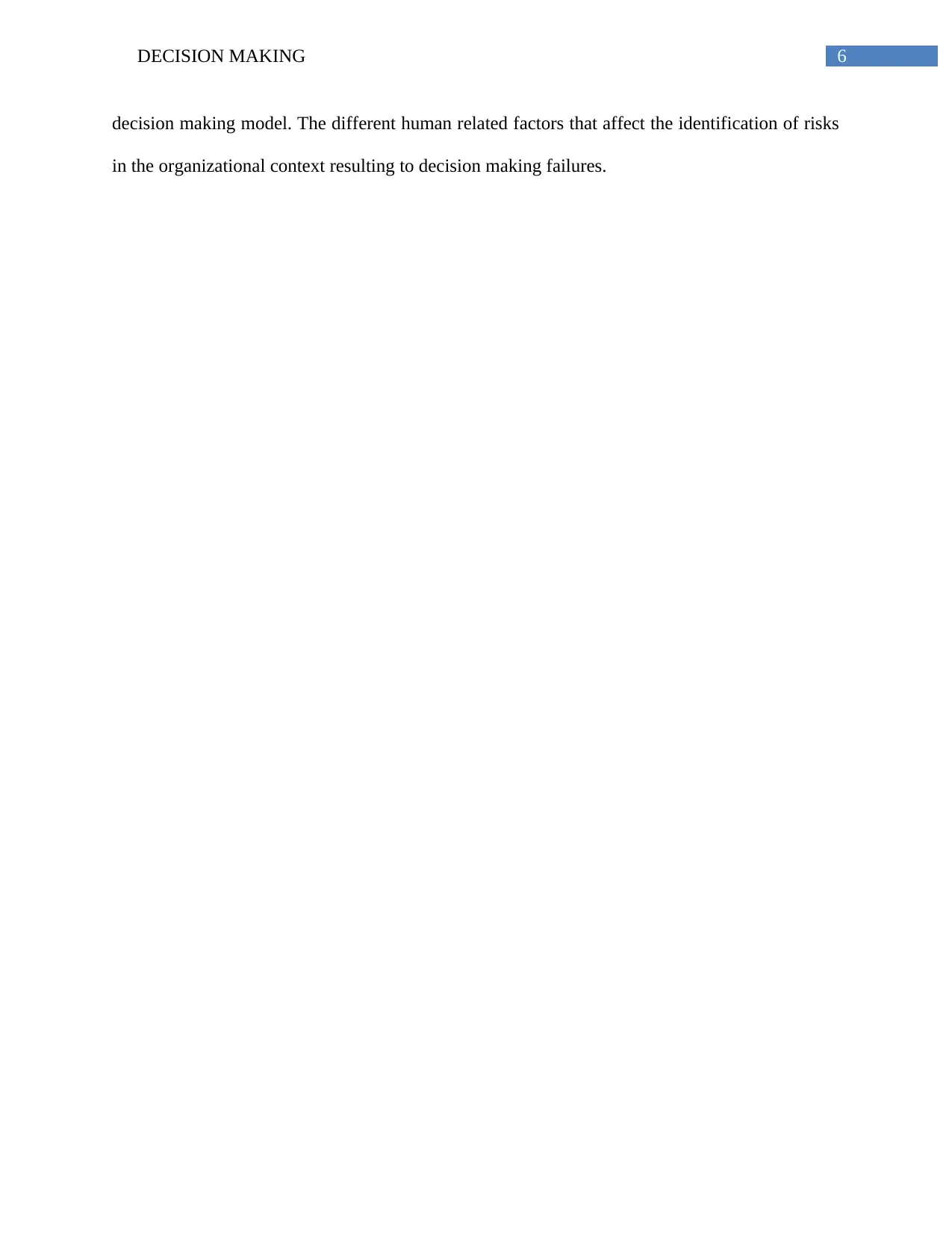
6DECISION MAKING
decision making model. The different human related factors that affect the identification of risks
in the organizational context resulting to decision making failures.
decision making model. The different human related factors that affect the identification of risks
in the organizational context resulting to decision making failures.
Paraphrase This Document
Need a fresh take? Get an instant paraphrase of this document with our AI Paraphraser
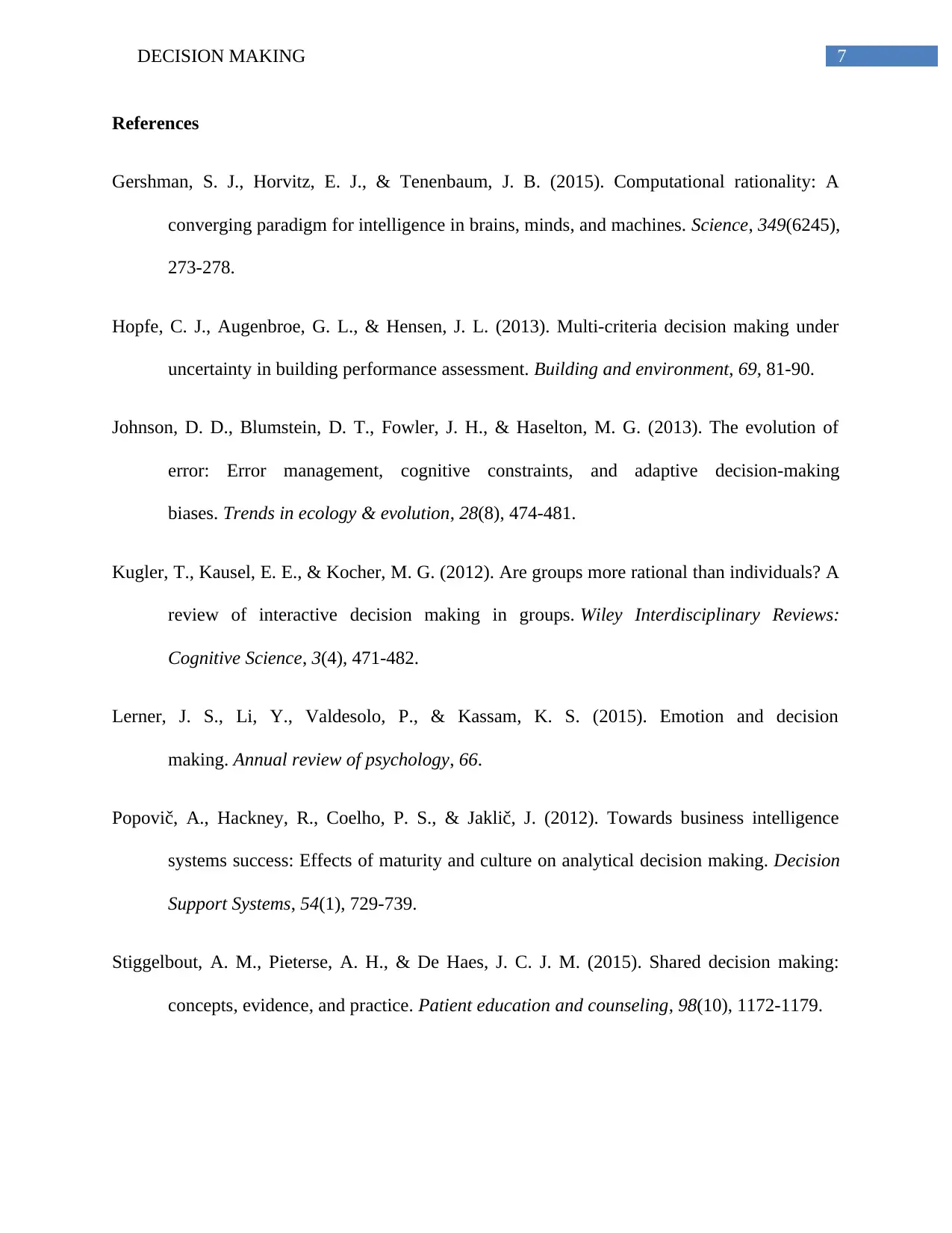
7DECISION MAKING
References
Gershman, S. J., Horvitz, E. J., & Tenenbaum, J. B. (2015). Computational rationality: A
converging paradigm for intelligence in brains, minds, and machines. Science, 349(6245),
273-278.
Hopfe, C. J., Augenbroe, G. L., & Hensen, J. L. (2013). Multi-criteria decision making under
uncertainty in building performance assessment. Building and environment, 69, 81-90.
Johnson, D. D., Blumstein, D. T., Fowler, J. H., & Haselton, M. G. (2013). The evolution of
error: Error management, cognitive constraints, and adaptive decision-making
biases. Trends in ecology & evolution, 28(8), 474-481.
Kugler, T., Kausel, E. E., & Kocher, M. G. (2012). Are groups more rational than individuals? A
review of interactive decision making in groups. Wiley Interdisciplinary Reviews:
Cognitive Science, 3(4), 471-482.
Lerner, J. S., Li, Y., Valdesolo, P., & Kassam, K. S. (2015). Emotion and decision
making. Annual review of psychology, 66.
Popovič, A., Hackney, R., Coelho, P. S., & Jaklič, J. (2012). Towards business intelligence
systems success: Effects of maturity and culture on analytical decision making. Decision
Support Systems, 54(1), 729-739.
Stiggelbout, A. M., Pieterse, A. H., & De Haes, J. C. J. M. (2015). Shared decision making:
concepts, evidence, and practice. Patient education and counseling, 98(10), 1172-1179.
References
Gershman, S. J., Horvitz, E. J., & Tenenbaum, J. B. (2015). Computational rationality: A
converging paradigm for intelligence in brains, minds, and machines. Science, 349(6245),
273-278.
Hopfe, C. J., Augenbroe, G. L., & Hensen, J. L. (2013). Multi-criteria decision making under
uncertainty in building performance assessment. Building and environment, 69, 81-90.
Johnson, D. D., Blumstein, D. T., Fowler, J. H., & Haselton, M. G. (2013). The evolution of
error: Error management, cognitive constraints, and adaptive decision-making
biases. Trends in ecology & evolution, 28(8), 474-481.
Kugler, T., Kausel, E. E., & Kocher, M. G. (2012). Are groups more rational than individuals? A
review of interactive decision making in groups. Wiley Interdisciplinary Reviews:
Cognitive Science, 3(4), 471-482.
Lerner, J. S., Li, Y., Valdesolo, P., & Kassam, K. S. (2015). Emotion and decision
making. Annual review of psychology, 66.
Popovič, A., Hackney, R., Coelho, P. S., & Jaklič, J. (2012). Towards business intelligence
systems success: Effects of maturity and culture on analytical decision making. Decision
Support Systems, 54(1), 729-739.
Stiggelbout, A. M., Pieterse, A. H., & De Haes, J. C. J. M. (2015). Shared decision making:
concepts, evidence, and practice. Patient education and counseling, 98(10), 1172-1179.
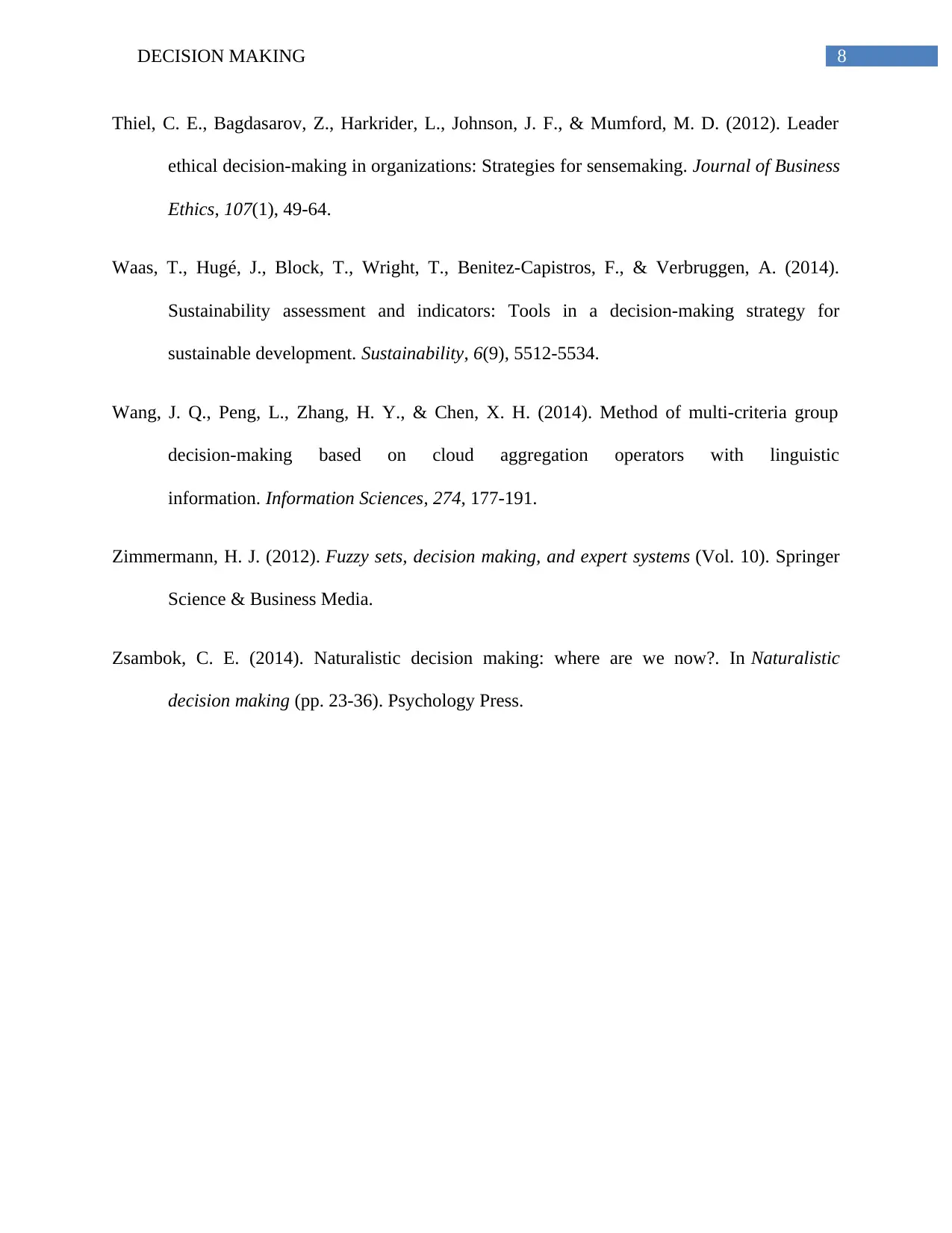
8DECISION MAKING
Thiel, C. E., Bagdasarov, Z., Harkrider, L., Johnson, J. F., & Mumford, M. D. (2012). Leader
ethical decision-making in organizations: Strategies for sensemaking. Journal of Business
Ethics, 107(1), 49-64.
Waas, T., Hugé, J., Block, T., Wright, T., Benitez-Capistros, F., & Verbruggen, A. (2014).
Sustainability assessment and indicators: Tools in a decision-making strategy for
sustainable development. Sustainability, 6(9), 5512-5534.
Wang, J. Q., Peng, L., Zhang, H. Y., & Chen, X. H. (2014). Method of multi-criteria group
decision-making based on cloud aggregation operators with linguistic
information. Information Sciences, 274, 177-191.
Zimmermann, H. J. (2012). Fuzzy sets, decision making, and expert systems (Vol. 10). Springer
Science & Business Media.
Zsambok, C. E. (2014). Naturalistic decision making: where are we now?. In Naturalistic
decision making (pp. 23-36). Psychology Press.
Thiel, C. E., Bagdasarov, Z., Harkrider, L., Johnson, J. F., & Mumford, M. D. (2012). Leader
ethical decision-making in organizations: Strategies for sensemaking. Journal of Business
Ethics, 107(1), 49-64.
Waas, T., Hugé, J., Block, T., Wright, T., Benitez-Capistros, F., & Verbruggen, A. (2014).
Sustainability assessment and indicators: Tools in a decision-making strategy for
sustainable development. Sustainability, 6(9), 5512-5534.
Wang, J. Q., Peng, L., Zhang, H. Y., & Chen, X. H. (2014). Method of multi-criteria group
decision-making based on cloud aggregation operators with linguistic
information. Information Sciences, 274, 177-191.
Zimmermann, H. J. (2012). Fuzzy sets, decision making, and expert systems (Vol. 10). Springer
Science & Business Media.
Zsambok, C. E. (2014). Naturalistic decision making: where are we now?. In Naturalistic
decision making (pp. 23-36). Psychology Press.
⊘ This is a preview!⊘
Do you want full access?
Subscribe today to unlock all pages.

Trusted by 1+ million students worldwide

9DECISION MAKING
Paraphrase This Document
Need a fresh take? Get an instant paraphrase of this document with our AI Paraphraser

10DECISION MAKING
1 out of 11
Related Documents
Your All-in-One AI-Powered Toolkit for Academic Success.
+13062052269
info@desklib.com
Available 24*7 on WhatsApp / Email
![[object Object]](/_next/static/media/star-bottom.7253800d.svg)
Unlock your academic potential
Copyright © 2020–2025 A2Z Services. All Rights Reserved. Developed and managed by ZUCOL.





